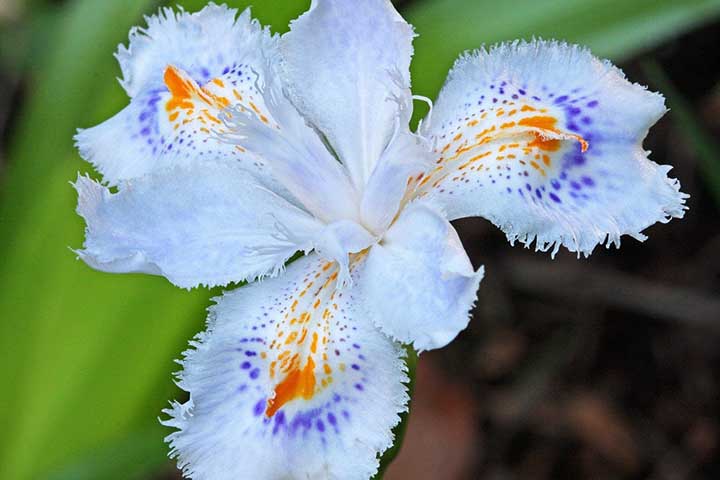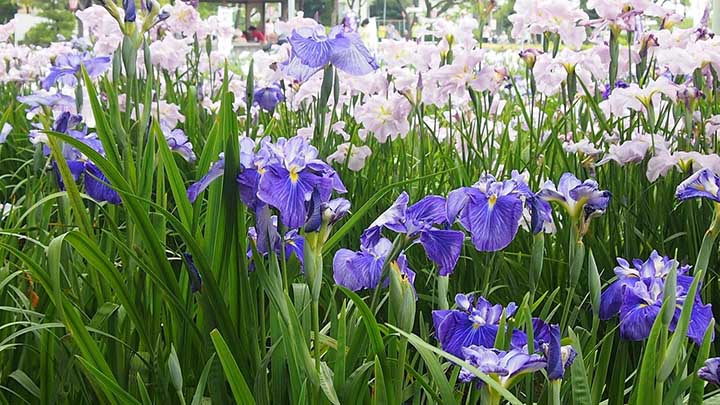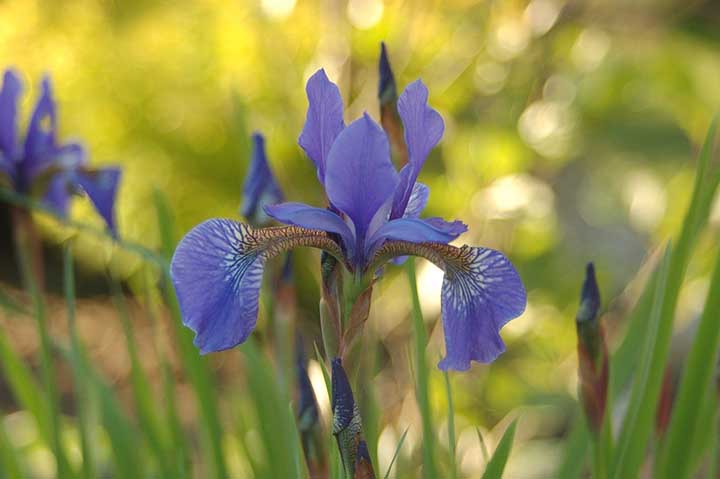There are over 200 different types of iris. Many people grow Japanese irises (Iris ensata or Iris kaempferi) and Siberian irises (Iris sibirica) in their gardens. You may wonder, “What is the difference between Japanese Iris and Siberian Iris?”
Irises are addictive. Many people try to grow as many species as possible. This guide will help you tell the difference between Japanese Iris and Siberian Iris.
Table of Contents
What Is the Difference Between a Japanese Iris and a Siberian Iris?
The primary difference between Japanese iris and Siberian iris is the plant size, bloom size, and soil moisture tolerance. Japanese irises have very large blooms, but Siberian irises have larger plants. In addition, Siberian irises tolerate dry and wet soils, while Japanese irises need consistently moist soil.
| Attribute | Japanese Iris | Siberian Iris |
| Height | 24-48 inches | 36-48 inches |
| Width | 24 inches | 24 inches |
| Leaf Color | Jade to Kelly green | Jade to Kelly green with a bluish cast in shifting light |
| Leaf Shape | Sword shape and linear, prominent midrib vein, tips flop over | Sword shape and linear, tip erect |
| Flower Size | 10 inches across | 3 inches across |
| Soil | Moist soil | Moist soil, tolerates wet soil or drought |
| pH | Acidic | Acidic to Neutral |
| USDA Hardiness Zone | 4a-9a | 3a-9a |
Comparison Table between Japanese Iris and Siberian Iris
Plant Size
Japanese Iris: These irises grow to be two to four feet tall. They will grow to be two feet in width.
Siberian Iris: These irises are larger, growing three to four feet tall. They will grow to be two feet in width.
Leaf Shape and Color
Japanese Iris: The leaves are sword-shaped and narrow. The tips of the leaves flop over. The leaves have a prominent midrib vein and are jade to Kelly green.
Siberian Iris: The leaves are also sword-shaped and narrow, but the tips do not flop over. The leaves are jade to Kelly green but have a bluish cast in shifting light.
Flower Size
Japanese Iris: These flowers are very large, ruffled, and flat. They grow to be ten inches across.
Siberian Iris: The flowers are much smaller and only get to be three inches across.
Soil Requirements and pH
Japanese Iris: This iris needs moist soil. It does well on the banks of streams and ponds but does not like wet feet. The Japanese iris is not drought tolerant.
Siberian Iris: This iris prefers moist soil. It will grow in bog conditions, however. Siberian irises are also more tolerant of drought than Japanese irises.
USDA Hardiness Zone
Japanese Iris: The Japanese Iris grows from zone 4a-9a. They tolerate temperatures in winter from –5 to –30 degrees F.
Siberian Iris: The Siberian iris grows from zones 3a-9a. They will tolerate winter temperatures of –35 to –40 degrees F.
Growing Japanese Iris and Siberian Iris

Despite their differences, Japanese and Siberian irises are grown similarly. Here are the conditions they need to grow their best.
Planting
To plant an iris, dig two trenches with a ridge between them. Place the rhizome on the ridge and spread the roots in each trench. Then, fill the trenches in and just cover the rhizome with soil.
Soil
Both types of irises need lots of organic matter in the soil to do well. The Japanese iris needs good drainage, while the Siberian iris is more tolerant of wet feet. Slightly acidic soil is best. If you have alkaline soil, incorporate peat moss into the soil to make it more acidic.
Light
Both types of irises do best with at least six hours of sunlight. They will tolerate partial sun, but the blooms will not look as spectacular. Partial shade will also lead to fewer blooms.
Water
Even moisture will give you the healthiest irises. Japanese iris needs to be watered often enough that the soil remains moist but not soggy. An inch a week works well in most places. Siberian iris can tolerate dry soil once established but will grow better with even moisture. They will also grow in a bog with wet feet, although they are more prone to crown rot there.
Fertilizer
Japanese and Siberian irises rebloom, so they need fertilizer all season. In early spring, fertilize your irises with a fertilizer low in nitrogen and high in phosphorous and potassium, such as a 5-10-10. Repeat every four weeks during the spring and summer. Do not fertilize in the fall and winter. Do not allow the fertilizer to touch the rhizome.
Deadheading
Remove the flower stalk where it joins the crown when a bloom is spent. Deadheading helps the plant conserve energy and also stimulates new blooms.
Propagation
Every three years, dig your iris up and divide it in the spring. Use a sharp spade or knife and cut the rhizome into several pieces. Each piece should have several leaves and as many roots as possible. Replant the original iris and then plant the new plants eight to ten inches apart for a massed effect or eighteen inches apart for a border effect.
Pests and Diseases
Both Japanese and Siberian irises are healthier than bearded irises. They do have some problems, however. Here are the most common ones.
Leafspot
Leafspot causes small circular spots on the leaves of irises. The spots start yellow. Then, they turn tan or brown with a red halo. While leafspot doesn’t usually kill irises outright, it reduces the vigor of the plants and can wear them down over time.
Control leafspot by removing all infected leaves immediately. Each fall, rake all plant matter up and remove it. Do not get the leaves wet when watering. Drip irrigation or applying water at the root zone will help prevent leafspot. Space your irises so air can circulate among them and quickly dry any leaves that get wet.
Soft Rot
Soft rot is caused by a bacterium known as Erwinia carotovora. The rhizome and lower leaf sheaf rot and turn black and mushy. The rot causes a foul smell. Because the rhizome rots, the leaves turn yellow and die. The bacterium enters the rhizome from wounds in the plant.
Planting the rhizome too deep predisposes the iris to soft rot. Plant the rhizome, so the top of it is barely covered by soil. When dividing the iris, discard any badly affected by soft rot. Cut any rotten spots out of the rhizome and plant the irises somewhere else. Let the soil dry out for a season before planting irises there again.
Iris Borers
Iris borers are a serious pest of irises. The moth lays eggs in old plant debris in the fall. In the spring, the larvae bore into the lower leaves and eat the interior. As they eat, the larvae work their way down to the rhizome. The larvae then eat the interior of the rhizome, killing the plant. When they exit the rhizome, the larvae pupate in the soil. In addition to the damage the larvae do to the iris, soft rot often enters the wounds they leave.
Because these larvae are inside the leaves and rhizomes, it isn’t easy to control them with pesticides. However, when leaves are five to six inches long, you can use a pyrethrin-based pesticide in the spring. Then, as the eggs hatch and the caterpillar crawls over the pyrethrin-treated plant, the pyrethrin will kill it. In addition, clean up and destroy old leaves, plants, and foliage each fall, so the eggs are destroyed.

In conclusion, Japanese iris and Siberian iris are very similar. The blooms on the Japanese iris are very large, while the Siberian iris has smaller blooms. Siberian iris plants grow larger, and the leaves have a slightly bluish tint. Siberian iris tolerate a wider range of soil moisture than Japanese iris. However, both irises have the same basic needs.
